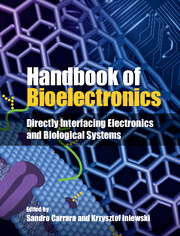Book contents
- Frontmatter
- Contents
- List of Contributors
- 1 What is bioelectronics?
- Part I Electronic components
- Part II Biosensors
- Part III Fuel cells
- Part IV Biomimetic systems
- Part V Bionics
- Part VI Brain interfaces
- 27 Introduction to brain–machine interfaces
- 28 ECG technology for the brain–machine interface
- 29 Reducing the implant footprint: low-area neural recording
- 30 Electrical stimulation
- 31 Biological channel modeling and implantable UWB antenna design for neural recording systems
- 32 Intracranial epilepsy monitoring using wireless neural recording systems
- 33 Low-power building blocks for neural recording systems
- 34 CMOS circuits for intracellular brain–machine interfaces
- Part VII Lab-on-a-chip
- Part VIII Future perspectives
- Index
- References
32 - Intracranial epilepsy monitoring using wireless neural recordingsystems
from Part VI - Brain interfaces
Published online by Cambridge University Press: 05 September 2015
- Frontmatter
- Contents
- List of Contributors
- 1 What is bioelectronics?
- Part I Electronic components
- Part II Biosensors
- Part III Fuel cells
- Part IV Biomimetic systems
- Part V Bionics
- Part VI Brain interfaces
- 27 Introduction to brain–machine interfaces
- 28 ECG technology for the brain–machine interface
- 29 Reducing the implant footprint: low-area neural recording
- 30 Electrical stimulation
- 31 Biological channel modeling and implantable UWB antenna design for neural recording systems
- 32 Intracranial epilepsy monitoring using wireless neural recording systems
- 33 Low-power building blocks for neural recording systems
- 34 CMOS circuits for intracellular brain–machine interfaces
- Part VII Lab-on-a-chip
- Part VIII Future perspectives
- Index
- References
Summary
Introduction
“How does the brain work?” This question, which has been askedthroughout the history of mankind, is addressed by all branches of science,in particular life sciences, from different perspectives. Although all seeka different answer, the common feature that triggers the research isobservation. This, together with curiosity, is whatmakes the beginning of a scientific study. From the electrical engineeringperspective, observations are performed by recording the electrical signalsgenerated by the neurons and interpreting the results. These interpretationsguide the research of scientists who are trying to map the brain, or tounderstand the mechanisms behind neurological disorders, or to implementbrain–machine interfaces [1]. Methods for recording the neuralsignals have evolved to the current state over decades, and the evolutionstill goes on. This chapter introduces the main concepts of thenew-generation neural recording systems: implantable wireless neuralrecording systems with a case study on in vivo epilepsymonitoring.
Current clinical practice in recording electrical activities of the brain isdominated by electroencephalography (EEG) which is a non-invasive procedureperformed along the scalp. Another type of EEG, intracranial EEG (iEEG; alsoknown as electrocorticography, ECoG), is an invasive procedure which isperformed by placing an electrode matrix (or array) onto the cortexfollowing the craniotomy as presented in Figure 32.1 [2]. Intracranial EEGis employed for epileptic focus localization prior to the resective surgery[3] which is performed to treat certain types of epilepsy. New-generationneural recording systems [4] aim to alter two main features of conventionaliEEG: (1) macro-sized iEEG electrodes will be replaced with microelectrodearrays (MEA) fabricated with microtechnology, and (2) transcutaneous wirescarrying neural information will be eliminated thanks to wireless datacommunication.
Information
- Type
- Chapter
- Information
- Handbook of BioelectronicsDirectly Interfacing Electronics and Biological Systems, pp. 389 - 399Publisher: Cambridge University PressPrint publication year: 2015
References
Accessibility standard: Unknown
Why this information is here
This section outlines the accessibility features of this content - including support for screen readers, full keyboard navigation and high-contrast display options. This may not be relevant for you.Accessibility Information
- 1
- Cited by
